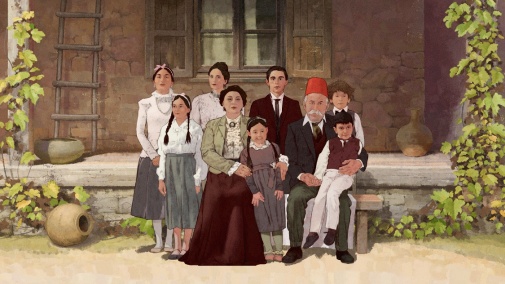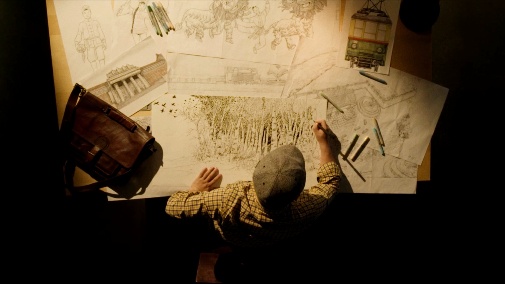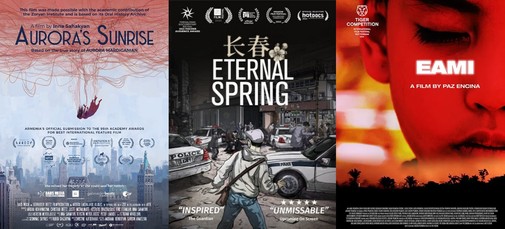Best International Film Reviews: Armenia, Canada and Paraguay
 Tuesday, December 13, 2022 at 8:00PM
Tuesday, December 13, 2022 at 8:00PM Submitting a documentary is a risky strategy in the Best International Film race. Since Waltz with Bashir in 2008, only four other non-fiction features have been able to score nominations in the category – Cambodia's The Missing Picture, North Macedonia's Honeyland, Romania's Collective, and Denmark's Flee. None of them won. Still, hope is everlasting, and one often finds that some of the year's most fascinating submissions happen to be documentaries. The same is true for our current season, with two titles going as far as incorporating animation, like Waltz with Bashir and Flee. Mayhap they can repeat their antecessors' success at getting nominated. It's unlikely but not impossible…
AURORA'S SUNRISE (Armenia)
 © ARTBOX laisvalaikio klubas
© ARTBOX laisvalaikio klubas
In 1919 Hollywood, a film called Auction of Souls was produced, based on the true tale of Arshaluys Mardiganian, renamed Aurora, a teen who had survived the Armenian Genocide. The actual woman performed the role, and the epic became a box office hit in the early 20s while also functioning as the basis for a fundraising action. However, most known copies of the film disappeared in the incoming decades as US-Turkish relations strengthened. Effectively, Auction of Souls was erased from the annals of history. Finally, in 1994, shortly after Aurora's death, some fragments were discovered, though the complete movie remains lost.
Using the remaining footage and contributions from the Zoryan Institute's Oral History Archive, director Inna Sahakyan purports to retell this story, shedding light onto a forgotten life through a mixed-media project – Aurora's Sunrise. The nature of the film becomes apparent immediately after a series of title cards expose most of the information above. An elderly Aurora unfolds a massive poster for her big Hollywood break, describing her memory as the picture of her young self fills the screen. Pushing into the tattered one-sheet, interview footage gives way to an animated remembrance.
It's the premiere of Auction of Souls, glamour depicted in flat drawings given paper doll-like life through digital means. Rather than presenting what might seem like an immersive remembrance, the technique evokes impressionistic imprecision in fractured movements. And yet, we're still going into different mediums, different stages of filmed reality. On the screen of that big old cinema, an image glows with black-and-white scratchiness, derelict footage salvaged from what still exists of Auction of Souls. Another push-in, and we're inside that footage, watching as it morphs into more painterly animation.
Are we watching a representation of a representation or a more direct dramatization of Aurora's recollections? Of course, both can be true, and Sahakyan never repudiates a multiplicity of meanings. Instead, the director offers this kaleidoscope of trauma like a Russian doll of cinemas, each nested within the other. There's a touch of archeology to these mechanisms, but also an apparent attempt at visualizing the ineffable and the lost. While always guided by excerpts from late-in-life interviews or the narrated writings of Aurora herself, the film transcends mere illustration.
Despite a straightforward aesthetic, we're never just seeing the animated scenes as representations of immediate action. They are refractions across the years and accumulated tragedies, portraying something as devastating as a family's annihilation with odd beauty. Consider the cyclical scene of a childish theater, each player disappearing until all that's left is Aurora standing alone in a ruined backyard, surrounded by silkworm chrysalis dyed blood-red. Such gestures reinforce the fundamental conception of Aurora's Sunrise as a memory play.
It's important to underline this aspect of the film because, otherwise, one might find themselves bristling at how little historical context is provided on the Armenian Genocide. Aurora's Sunrise isn't the tale of a world event but the personal odyssey of one young woman traversing the world in exile, the life she knew collapsed in a torrent of carnage and turned into a Chaplin-starring screen dream, perhaps a new nightmare. Though the visual language never fully tries to replicate silent film styles, the narrative structure hews close to the epic cinema of yore. There's a good deal of sentimentality, too, an occasionally mawkish score tipping the scales too much toward melodrama.
Still, it's impossible to deny the picture's inventiveness, its sentimental wallop, the eeriness of its painterly horrors, its splendor. As a cinematic document against historical erasure, it deserves your attention. B
ETERNAL SPRING (Canada)
 © Lofty Sky Pictures
© Lofty Sky Pictures
Jason Loftus' Eternal Spring opens with an astonishing five-minute oner. The virtual camera knows no bounds, performing the kind of dizzying movements that even Mikhail Kalatozov couldn't imagine. Floating freely across urban spaces, through walls and floors, the floating eye documents a rhapsody of violence perpetrated against the Falun Gong practitioners who dared to hijack a state TV station in 2002 Changchun. It's dizzying and horrifying, oppression made into an immersive hallucination. Such sights are why animation is so precious as a medium, why it can become a vital visual language for non-fiction filmmaking.
Unbound from the limits of reality, it can represent calcinating truth beyond the barriers of the physical world, of time and space. In this particular case, animation allows for the creation of art based on a shared memory. That remembrance is not done by Loftus but by Falun Gong practitioners outside China who still remember their fallen brethren and maintain their legacy alive. Among them is Daxiong, a comic book artist who wasn't a part of the hijacking team but still ran away from his homeland during the ensuing crackdown on whoever tried to speak up about the state's brutality against the religious group.
Indeed, his graphic art is the basis for the animated sequences, his process the backbone of the film. It further frames other storytelling devices, including archival footage edited into comic book pages or how, instead of taking notes during interviews, Daxiong sketches the survivors' testimony. It's not a gimmick but an expression of selfhood that better defines the film as one man's meditation on traumatic events, his attempt at honoring others who sacrificed everything for the cause of freedom. It also helps imbue the journalistic efforts with personal stakes, a sense of elegy, art as a vehicle for catharsis, personal growth.
Sometimes we see storyboards, quick sketches, concept art, and even sculptures that suggest the 3D grids onto which Daxiong draws 2D details. Often, one finds the artist interpreting others' words or giving new life to those who are no longer with us. On other occasions, however, thrilling sequences unfold like materialized nostalgia. Insights into the artist's childhood drip with yearning, canonizing a Changchung that is no more and only now exists in memories. Birch trees have eyes in these longing dreams, and kids' imaginations erupt into cloud-like giants posing over the landscape – heroes of Chinese legend juxtaposed to the heroes modern China turned into martyrs.
And what heroes they are. Several characters emerge from real-life events throughout Eternal Spring, whether painful versions of lost youth or political victims made into striking big-screen presences. Moreover, one grows attached to them and, even while knowing what's going to happen, these sentiments effectively make the film's back half into a nerve-wracking heist picture. A man nicknamed Big Truck stands out among various figures as he becomes an emotional anchor for the flick. His fate is one of the project's most heartbreaking revelations, a strike that's like a sledgehammer to the solar plexus.
Such qualities define the documentary as a monument of grief, reaching for flickers of hope. If there's one major quibble, it's that the final animation never quite matches the beauty of the 2D drawings nor the raw emotion they evoke. There's also the matter of the final passages being too pat and neatly tied up. Nevertheless, those caveats aren't enough to nullify Eternal Spring's power. B/B+
EAMI (Paraguay)
 © Estudios Splendor Omnia
© Estudios Splendor Omnia
For the first ten minutes, all one can see is the earth and a sliver of water nearby, leaves littered over the ground and a little nest of four eggs. The camera is static, patient as it observes changes in light that seem to defy naturalist time. At the same time, everything seems to happen too fast and too slowly, transmutations of folly sound suggesting a forest awakening and then dying, while shifting colors paint the frame in morning blues giving in to sunset shades. That is until another night – how many were there? – plunges the shot into darkness disrupted by an ominous glow. The forest is aflame.
Our setting is the Paraguayan Chaco, a territory that bears the sad status of having the highest deforestation rate in the world. Each month, 25000 hectares of woodland are ruthlessly processed by industrial forces. Only the Totobiegosode people stand between the forest and its enemies, having won legal protection over the place they call their ancestral land. Eami – meaning forest and world – is their story of resilience told in willful abstraction, appealing to their spiritualist beliefs. Notice that, above that first shot, a voice is heard. It belongs to Asoja, an omniscient presence, who tells the audience about the people's mythos, how the universe was created, and such higher beings came to be.
Asoja is a god and a girl called Eami, an animal made human, a bird made bigger than life, a miracle made flesh. They will also be our narrator henceforth, our guide into an Indigenous imagination far removed from what one usually encounters projected big on the silver screen. Anticolonialist ideas thus manifest in the shape of a rejection. Eami moves away from conventions forged by those who do not share the Ayoreo Totobiegosode heritage – rebellion in structural and formalistic terms. It's both slight and monumental, for vocal description alone can shapeshift the world. Under such spells, the placidity of the jungle becomes a cosmic theater.
Reflecting upon all this, the opening salvo emerges as something of a trial by fire for the viewer, asking if they're willing to attune to Eami's wavelength. It also teaches how to watch this particular creation. One must trust its ambitions for a natural poetry capable of supplanting precepts of action or narrative, maybe even cinema as imagined by western industry. We're before a project founded in the will to preserve a dying culture and let its sensibilities shape film form. The result is a meditative ode cum funeral chant, a song for a homeland destroyed by invaders and will soon disappear if the process doesn't halt.
Look at it from a different perspective, and it reveals a celebration of storytelling, the forest seemingly accommodating whatever tale Asoja means to speak into being using Eami's mouth. An activist urgency courses through the picture's veins, but maybe the greatest warrior is the invisible spirit within which the entire forest resides. That political intent never overrides a measured voice birthed out of communal beliefs passed from generation to generation. It never becomes something too stable or concrete. Here, epochs collide as the poem unfolds, words of wisdom carried by the wind kissing naked backs. Present and past are one in this place, and today is forever.
Every boundary crumbles under the pressure of primordial influences. And so do the limits between humanity and the divine become difficult to ascertain, the porous membrane separating people from nature evanescing into nothingness. Its futile attempts to categorize art get bent out of shape in the face of Eami, for this is no ordinary documentary, nor is it drama. It lives in the in-between and fits better into ideas of experimentalism. But even then, the categorization feels wrong. Why do we need to fit everything into boxes in the first place? Director Paz Encina shatters all those boxes, shattering reductive notions of what film can be with delicate touches that reverberate like earthquakes. A-
Oscar odds? Despite Eami's triumph on the festival circuit – it won the Tiger Award upon its world premiere in Rotterdam – such success won't necessarily translate into Oscar buzz. The same goes for Aurora's Sunrise, even if its mix of pathos and film history might elevate its profile with voters. The recently released Eternal Spring is the most probable entry into the shortlist.



